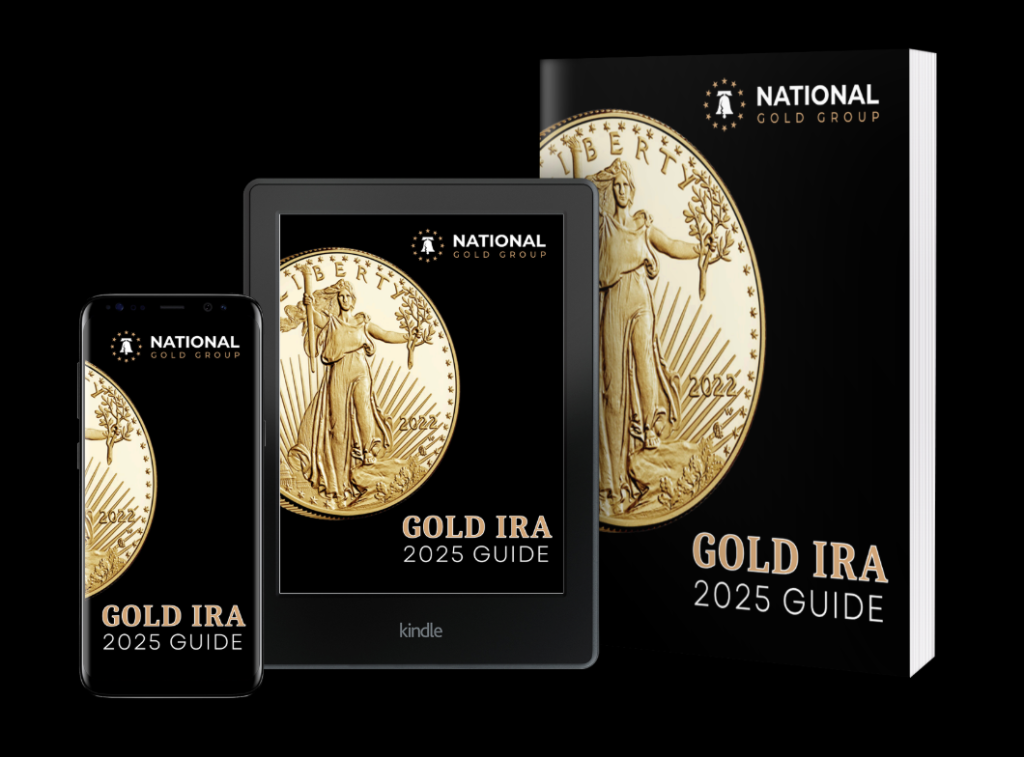Are Gold Sales Reported to the IRS?

Navigating the labyrinth of IRS rules can feel like an Olympic event, especially when dealing with gold sales. Yes, you’re right to ask, ‘Are gold sales reported to the IRS?’
Certain sales and transactions involving gold are indeed reported to the IRS. To better understand this subject, we will explore the following points:
- Circumstances for Reporting Transactions
- Form 1099-B Explained
- Reporting Criteria for Bars and Rounds
- Reporting Criteria for Coins
- Tax Implications of Selling Physical Gold or Silver
- Cost Basis of Physical Gold and Silver
- Tax Example and Offset Possibilities
- Reporting Sales of Precious Metals
- Buying and Selling Gold and Silver Through a Gold IRA
This article will unravel the mystery, helping you understand when and how to report these sales. We’ll delve into the forms to use, the criteria for reporting, and the tax implications.
So, relax. Let’s turn this taxing task into a walk in the park. Knowledge is power, and we’re here to empower you.

Circumstances for Reporting Transactions
Understanding the circumstances under which gold sales are reported to the IRS is crucial for your compliance with tax laws and regulations. Whether you’re a dealer or a consumer, knowledge of these requirements can save you from potential legal and financial repercussions.
As a precious metals dealer, you’re obliged to report consumer transactions to the IRS. This reporting is essential when a consumer sells reportable quantities of specific bullion or coins. It’s also required if a consumer purchases goods from you and pays with $10,000 or more in cash. While the former is a tax issue, the latter is an anti-money laundering measure.
When reporting sales of bullion or coins, you must fill out Form 1099-B and submit it to the IRS. Fail to do so, and you’re looking at possible monetary fines or even criminal charges. It’s important to note that any customer information provided to the IRS remains strictly confidential, safeguarding your client’s privacy.
The reporting criteria for bars and rounds depend on the purity and quantity of the products. For instance, gold bars and rounds must have a fineness of at least .995 and a total purchase quantity of 1 kilo or more. Similarly, reporting criteria for coin sales are specific and straightforward, with certain coins requiring a minimum of 25 pieces to be reported.
Form 1099-B Explained
Now, let’s delve into the details of Form 1099-B, a crucial document you’ll encounter when selling reportable quantities of bullion or coins. This form, part of the broader 1099 series, is used to report gains or losses arising from certain customer transactions.
In the context of precious metals, Form 1099-B becomes mandatory when you sell items listed in the IRS’s Reportable Items List.
The criteria for reporting depend on the type of coin or bullion piece sold. For instance, specific gold coins such as the 1 oz Gold Maple Leaf or the 1 oz Gold Krugerrand, if sold in a quantity of 25 or more, must be reported using Form 1099-B. For silver, if you’re selling U.S. coins with 90% silver content exceeding a face value of $1,000, this too necessitates a 1099-B.
Form 1099-B isn’t just a bureaucratic formality. It plays a crucial role in preventing tax evasion and in tracking individuals who are using asset sales as a source of income. When you sell, your precious metals dealer fills out this form and submits it to the IRS. It’s important to note that failure to meet these reporting requirements can result in financial penalties or even criminal charges.
Reporting Criteria for Bars and Rounds
If you’re selling bars and rounds of precious metals, it’s important to know that the reporting criteria depend on both the purity and quantity of the product. The IRS has specific reporting requirements for these types of transactions to track potential tax liability.
For gold bars and rounds, the purity must be at least .995, and the total quantity you’re selling must be 1 kilo (32.15 troy ounces) or more. Otherwise, you’re not required to report the transaction. For silver bars and rounds, the purity required is .999, and the total quantity must be 1,000 troy ounces or more.
Furthermore, when it comes to palladium and platinum bars or rounds, the criteria slightly differ. For palladium, the required purity is .9995 with a minimum total quantity of 100 troy ounces. In the case of platinum, the required purity is .9995, and you need to sell at least 25 troy ounces.
Remember, it’s essential to comply with these reporting requirements to avoid potential penalties from the IRS. Failure to do so can result in significant fines or even criminal charges. It’s also crucial to maintain accurate records of all your transactions involving precious metals. This won’t only assist you in reporting to the IRS but will also help to establish your cost basis for calculating potential capital gains or losses.
Understanding and complying with these reporting criteria can help you navigate the complexities of selling precious metals and ensure you’re meeting your tax obligations.
Reporting Criteria for Coins
While you’re likely familiar with the reporting criteria for bars and rounds, it’s also crucial to know the specific requirements when selling coins. Coins have distinct guidelines, and understanding these can help you stay compliant with IRS regulations.
Reportable coins include the 1 oz Gold Maple Leaf, 1 oz Gold Krugerrand Coins, 1 oz Gold Mexican Onza, and US coins composed of 90% silver. If you’re selling any of these specific gold coins, the IRS requires a report if the sale involves a minimum of 25 pieces. For 90% silver content US coins, sales exceeding a face value of $1,000 must be reported.
However, certain bullion products are exempt from this reporting rule. Gold coins with fractional denominations, for instance, don’t need to be reported. Also, sales of Gold or Silver American Eagle Coins aren’t reportable events.
To report the sale of these coins, dealers must file Form 1099-B with the IRS. This form is used to report gains or losses from these transactions. Properly filling out this form and submitting it in a timely manner is crucial to avoid penalties.

Tax Implications of Selling Physical Gold or Silver
The sale of physical gold or silver has specific tax implications that you should be aware of to avoid any surprises come tax season. When you sell these precious metals, the IRS considers them as capital assets, classified under collectibles. Consequently, you’re required to pay a capital gains tax if you’ve held these assets for more than a year. This tax equates to your marginal tax rate, capped at a maximum of 28%.
It’s crucial to note that for individuals in the 33%, 35%, and 39.6% tax brackets, the rate on their precious metals sales is 28%. If you’ve held these assets for less than a year, however, any gains are taxed at your ordinary income rates.
Sales of physical gold or silver must be reported on Schedule D of Form 1040. Certain types of metals may require the submission of Form 1099-B to the IRS at the time of sale. Examples include specific U.S. silver coins and certain gold bars. However, sales of American Gold Eagle coins don’t need a Form 1099-B. The tax due for these sales aligns with your ordinary income tax bill’s timeline.
Your tax liability on the sale of precious metals hinges on the cost basis, which is the amount you paid for the metal, plus certain costs. Capital losses on other collectibles can offset this tax liability, offering some relief. Understanding these tax implications helps you comply with the law and avoid penalties or fines.
Buying gold and silver through a tax-deferred gold IRA company that has a reasonable buyback policy can simplify the process tremendously. Each of the 4 gold IRA and precious metal investment companies we have researched have competitive prices as well as buyback policies.
Depending on whether you are a high-net investor looking for the most competitive prices or require a lower investment minimum and affordable entry to the gold market, or whether you prefer a gold IRA or owning physical gold in your place of residence.
To learn more about the advantages of tax-deferred gold IRAs right now, click the banner below to access and download Augusta Precious Metals’ gold IRA checklist to make sure you are aware of all aspects of the gold IRA process:
Cost Basis of Physical Gold and Silver
You might be wondering how your tax bill on the sale of precious metals is calculated, and that’s where the concept of cost basis comes into play. The cost basis of your physical gold or silver is essentially what you originally paid for it, plus any required costs or fees that were part of the purchase.
- Cost Basis Calculation
- Purchase Price: The primary component of your cost basis is the amount you paid for the precious metal.
- Additional Costs: Any fees or costs related to the acquisition, such as dealer premiums or auction fees, are added to the purchase price to determine the total cost basis.
When you sell your gold or silver, the IRS will want to know your cost basis to calculate any capital gains tax owed.
- Tax Implication
- If you sell for more than your cost basis, you’ve made a profit and may owe taxes.
- If you sell for less than your cost basis, you’ve incurred a loss which might be deductible.
It’s also important to note how the cost basis is determined if the precious metal was received as a gift or inheritance.
- Special Cases
- Inherited Metals: The cost basis is the fair market value at the time of the original owner’s death.
- Gifted Metals: The cost basis is either the donor’s cost basis or the fair market value at the time of the gift, depending on various factors.
Understanding your cost basis can help you plan for any tax obligations when deciding to sell your precious metals.
To learn more about how gold investing can protect your long-term wealth and the advantages of tax-deferred gold IRAs, click the banner below to access and download NAtional Gold Groups’ free gold IRA guide to make sure you are aware of all aspects of the gold IRA process:
Tax Example and Offset Possibilities
To give you a clearer understanding of the tax implications when selling gold, let’s consider an example where you’ve purchased 100 ounces of gold at $1,330 per ounce and later sell it at $1,500 per ounce. Your initial investment, or cost basis, would be $133,000 (100 ounces x $1,330). If you sell the gold at $1,500 per ounce, you’d receive $150,000 (100 ounces x $1,500), leading to a capital gain of $17,000 ($150,000 – $133,000).
The IRS considers gold as a collectible, and the long-term capital gains tax (for assets held over a year) can go up to 28%. So, if you’re in a tax bracket that’s 28% or higher, you’d owe $4,760 (28% of $17,000) in taxes on this transaction.
However, your tax obligation can be offset by capital losses. If you’ve sold other collectibles at a loss in the same tax year, you can use these losses to offset your gain. For instance, if you’d a $2,000 loss from the sale of a collectible coin, your taxable gain from the gold sale would drop to $15,000 ($17,000 – $2,000), reducing your tax to $4,200.
If your losses exceed your gains, you can carry forward the remaining loss to offset future capital gains. This carry forward isn’t limited to one year, but remember to abide by the annual deduction limit for capital losses. It’s crucial to consult with a tax professional to ensure you’re correctly reporting your gains and losses to the IRS.
Buying and Selling Gold and Silver Through a Gold IRA
Conclusion
In summary, understanding IRS reporting requirements for gold and precious metals sales is crucial for investors. It’s not just about staying legal-it’s about leveraging your investment effectively.
Be aware of the circumstances for reporting, know the forms like 1099-B, and understand the reporting criteria for bars, rounds, and coins.
Consider the tax implications and potential offsets.
By doing so, you’ll navigate the precious metals market confidently and make informed decisions.
To learn more about whether buying gold coins is taxable read here.
If you have 100k of savings to protect and want to take advantage of the best gold prices and lifetime customer support, click the banner below to join a free gold and silver web conference hosted by Augusta Precious Metals. Secure your place today:
Obtain a gold IRA guide and talk to a broker




If you have 100k in savings to protect, attend a gold investment educational webinar hosted by Augusta Precious Metals. Tap the button below:
Gold IRA FAQs

Adam ONeill
Author, lifelong investor, and creator of PreciousMetalsInvestmentPortfolio.com


